A Review of Flywheel Energy Storage System Technologies
Abstract
:1. Introduction
| Features | Energy Storage Methods and Technologies | ||||
|---|---|---|---|---|---|
| Compressed Air Energy Storage | Chemical Battery Energy Storage | Superconducting Magnetic Energy | Supercapacitor Energy Storage | Flywheel Energy Storage | |
| Efficiency (%) | 40~60 | 70~80 | 80~95 | 80~95 | 85~95 |
| Specific energy (Wh/kg) | - | 3~15 | 1~10 | 0.2~10 | 5~150 |
| Specific power (W/kg) | - | 100~700 | 1000 | 7000~18,000 | 180~1800 |
| Charging time | hours | hours | hours | minutes | minutes |
| Discharge time | 1~20 h | 1 min~hours | 10 ms~15 min | 0.1 s~1 min | 15 s~15 min |
| Discharge depth | deep | shallow | deep | deep | deep |
| Response time | minute | milliseconds | milliseconds | milliseconds | milliseconds |
| Service life (Year) | >20 | 3–15 | >20 | >20 | >20 |
| Maintenance cycles | frequent | <6 months | frequent | >10 years | >10 years |
| Operating temperature (°C) | 35~50 | −10~+300 | 4.2~77 K | −30~+50 | −40~+50 |
| Environment requirements | high | medium | extremely high | high | low |
| Environmental features | no contamination | contamination | no contamination | no contamination | no contamination |
2. The Operation Principles and Components of Flywheel Energy Storage Systems
2.1. Structure of Flywheel Energy Storage Systems
2.2. Operating Principles of Flywheel Energy Storage Systems
2.3. Flywheel Rotors
2.4. Flywheel Motors
- It must be suitable for high-speed operation;
- The rotor structure should exhibit robust strength;
- It must ensure satisfactory power stability and high reliability;
- The input/output power should align with the flywheel’s charge and discharge needs;
- The motor/generator should have minimal losses across a wide speed range, offer high efficiency, and be user-friendly in its operation;
2.4.1. Induction Motors for Flywheel Energy Storage Systems
2.4.2. Switched Reluctance Motors for Flywheel Energy Storage Systems
2.4.3. Permanent-Magnet Motors for Flywheel Energy Storage Systems
2.4.4. Control Strategies for Flywheel Energy Storage Systems
2.5. Flywheel Bearings
2.5.1. Mechanical Bearings
2.5.2. Magnetic Bearings
- The absence of mechanical friction in magnetic bearings allows for high-speed operation. The maximum speed of a flywheel rotor supported by magnetic bearings is constrained only by the strength of the rotor material.
- Magnetic bearing systems are characterized by minimal losses, high efficiency, and negligible friction losses. They either require minimal power or are self-sustaining, which contributes to reduced energy loss during prolonged energy storage.
- The need for lubrication and sealing is eliminated with magnetic bearings. This minimizes lubricant contamination, obviates lubricant storage and filtration, and simplifies the system design.
- The non-contact nature of magnetic bearings ensures an extended lifespan and circum- vents issues commonly encountered in conventional bearings due to contact wear.
- PMBs paired with mechanical bearings;
- Active magnetic bearings combined with mechanical bearings;
- Electromagnetic bearings combined with permanent-magnet bearings. In this setup, the PMB supplies the axial unloading force, while the electromagnetic bearing modulates the radial displacement of the flywheel rotor;
- Superconducting bearings paired with permanent-magnet bearings, where PMs and HTSs are predominantly used as stators and rotors, respectively.
2.5.3. Research on Flywheel Energy Storage System Bearings
2.6. Power Electronic Converter
- To have a fast response speed and energy storage speed, it is necessary to control the speed of the integrated electric motor/generator within a wide speed range;
- When stored energy is released, it works in coordination with the integrated electric motor/generator to make the output frequency and voltage meet the load requirements;
- To improve the energy storage efficiency of the FESS, the bidirectional converter must have high efficiency over a wide speed range when charging and discharging;
- Furthermore, the output harmonic of the bidirectional converter should be small to reduce harmonic interference with the power grid and to the reduce harmonic loss of the motor or generator.
3. Flywheel Energy Storage System Applications
3.1. Power Quality
3.2. High-Quality Uninterruptible Power Supply
3.3. Pulse Power Supply
3.4. Energy Recovery, Storage, and Utilization
3.5. Commercial FESS Systems and Advantages of Using FESSs
4. Achievements, Challenges, Future Trends, and Case Study
4.1. Achievements and Challenges
4.2. Future Trends
4.2.1. FESS Material and Component Optimizations
- Advanced Flywheel Material Technologies
- Superconducting Magnetic Bearing Technologies
- Advanced High-Power-Density Motor Design Technologies
- High-Power-Density Drive Technology
4.2.2. FESS Control Systems
- Multi-level and Wide-range Control Schemes for FESSs
- FESS Arrays for Large Power Applications
4.2.3. FESS Loss, Failure Modes, and Containment
4.2.4. FESS Safety and Longevity
4.2.5. FESS Hybrid Systems
4.2.6. FESSs based on Artificial Intelligence
- Applications of AI in FESSs
- Effects of AI on FESSs
- Digital Twin Modeling of FESSs based on Data-driven Methods
4.3. Case Study
5. Conclusions
Author Contributions
Funding
Data Availability Statement
Conflicts of Interest
References
- BP, p.l.c. Statistical Review of World Energy 2022. 2023. Available online: https://www.bp.com/content/dam/bp/business-sites/en/global/corporate/pdfs/energy-economics/statistical-review/bp-stats-review2022-full-report.pdf (accessed on 5 August 2023).
- Braeuer, F.; Rominger, J.; McKenna, R.; Fichtner, W. Battery storage systems: An economic model-based analysis of parallel revenue streams and general implications for industry. Appl. Energy 2019, 239, 1424–1440. [Google Scholar]
- Killer, M.; Farrokhseresht, M.; Paterakis, N.G. Implementation of large-scale Li-ion battery energy storage systems within the EMEA region. Appl. Energy 2020, 260, 114166. [Google Scholar]
- Hemmati, R.; Saboori, H. Emergence of hybrid energy storage systems in renewable energy and transport applications–A review. Renew. Sustain. Energy Rev. 2016, 65, 11–23. [Google Scholar]
- Koot, M.; Kessels, J.T.; De Jager, B.; Heemels, W.; Van den Bosch, P.; Steinbuch, M. Energy management strategies for vehicular electric power systems. IEEE Trans. Veh. Technol. 2005, 54, 771–782. [Google Scholar] [CrossRef]
- Mehrjerdi, H. Dynamic and multi-stage capacity expansion planning in microgrid integrated with electric vehicle charging station. J. Energy Storage 2020, 29, 101351. [Google Scholar]
- Lazzeroni, P.; Olivero, S.; Repetto, M.; Stirano, F.; Vallet, M. Optimal battery management for vehicle-to-home and vehicle-to-grid operations in a residential case study. Energy 2019, 175, 704–721. [Google Scholar]
- Behabtu, H.A.; Messagie, M.; Coosemans, T.; Berecibar, M.; Anlay Fante, K.; Kebede, A.A.; Mierlo, J.V. A review of energy storage technologies’ application potentials in renewable energy sources grid integration. Sustainability 2020, 12, 10511. [Google Scholar] [CrossRef]
- Wang, K.B.; Xun, Q.; Zhang, Q. Recent progress in metal-organic frameworks as active materials for supercapacitors. EnergyChem 2020, 2, 100025. [Google Scholar]
- Wang, K.; Guo, Y.; Zhang, Q. Metal–organic frameworks constructed from iron-series elements for supercapacitors. Small Struct. 2022, 3, 2100115. [Google Scholar] [CrossRef]
- Abbas, Q.; Mirzaeian, M.; Hunt, M.R.; Hall, P.; Raza, R. Current state and future prospects for electrochemical energy storage and conversion systems. Energies 2020, 13, 5847. [Google Scholar]
- Sarbu, I.; Sebarchievici, C. A comprehensive review of thermal energy storage. Sustainability 2018, 10, 191. [Google Scholar] [CrossRef]
- Chen, X.; Zhang, Z.; Qi, C.; Ling, X.; Peng, H. State of the art on the high-temperature thermochemical energy storage systems. Energy Convers. Manag. 2018, 177, 792–815. [Google Scholar]
- Hou, R.; Song, H.; Nguyen, T.T.; Qu, Y.; Kim, H.M. Robustness improvement of superconducting magnetic energy storage system in microgrids using an energy shaping passivity-based control strategy. Energies 2017, 10, 671. [Google Scholar] [CrossRef]
- Alzahrani, A.; Ramu, S.K.; Devarajan, G.; Vairavasundaram, I.; Vairavasundaram, S. A review on hydrogen-based hybrid microgrid system: Topologies for hydrogen energy storage, integration, and energy management with solar and wind energy. Energies 2022, 15, 7979. [Google Scholar] [CrossRef]
- Enescu, D.; Chicco, G.; Porumb, R.; Seritan, G. Thermal energy storage for grid applications: Current status and emerging trends. Energies 2020, 13, 340. [Google Scholar]
- Boicea, V.A. Energy storage technologies: The past and the present. Proc. IEEE 2014, 102, 1777–1794. [Google Scholar]
- Choi, W.; Wu, Y.; Han, D.; Gorman, J.; Palavicino, P.C.; Lee, W.; Sarlioglu, B. Reviews on grid-connected inverter, utility-scaled battery energy storage system, and vehicle-to-grid application-challenges and opportunities. In Proceedings of the 2017 IEEE Transportation Electrification Conference and Expo (ITEC), Chicago, IL, USA, 22–24 June 2017; pp. 203–210. [Google Scholar]
- Hebner, R.; Beno, J.; Walls, A. Flywheel batteries come around again. IEEE Spectr. 2002, 39, 46–51. [Google Scholar] [CrossRef]
- Vazquez, S.; Lukic, S.M.; Galvan, E.; Franquelo, L.G.; Carrasco, J.M. Energy storage systems for transport and grid applications. IEEE Trans. Ind. Electron. 2010, 57, 3881–3895. [Google Scholar] [CrossRef]
- Lee, J.P.; Jeong, N.H.; Han, Y.H.; Han, S.C.; Jung, S.Y.; Park, B.J.; Sung, T.H. Assessment of the energy loss for SFES with rotational core type PMSM/G. IEEE Trans. Appl. Supercond. 2009, 19, 2087–2090. [Google Scholar]
- Lee, J.P.; Park, B.J.; Han, Y.H.; Jung, S.Y.; Sung, T.H. Energy loss by drag force of superconductor flywheel energy storage system with permanent magnet rotor. IEEE Trans. Magn. 2008, 44, 4397–4400. [Google Scholar]
- Lee, J.P.; Han, S.C.; Han, Y.H.; Sung, T.H. Loss characteristics of SFES with amorphous core for PMSM. IEEE Trans. Appl. Supercond. 2011, 21, 1489–1492. [Google Scholar] [CrossRef]
- Strasik, M.; Hull, J.; Mittleider, J.; Gonder, J.; Johnson, P.; McCrary, K.; McIver, C. An overview of Boeing flywheel energy storage systems with high-temperature superconducting bearings. Supercond. Sci. Technol. 2010, 23, 034021. [Google Scholar] [CrossRef]
- Peña-Alzola, R.; Sebastián, R.; Quesada, J.; Colmenar, A. Review of flywheel based energy storage systems. In Proceedings of the 2011 International Conference on Power Engineering, Energy and Electrical Drives, Malaga, Spain, 11–13 May 2011; pp. 1–6. [Google Scholar]
- Ertz, G.; Twiefel, J.; Krack, M. Feasibility study for small scaling flywheel-energy-storage systems in energy harvesting systems. Energy Harvest. Syst. 2014, 1, 233–241. [Google Scholar] [CrossRef]
- Kale, V.; Secanell, M. A comparative study between optimal metal and composite rotors for flywheel energy storage systems. Energy Rep. 2018, 4, 576–585. [Google Scholar] [CrossRef]
- Fang, S.; Lv, Z.; Chao, G. Methods of increasing the energy storage density of superconducting flywheel. IEEE Trans. Appl. Supercond. 2021, 31, 1–5. [Google Scholar] [CrossRef]
- Conteh, M.A.; Nsofor, E.C. Composite flywheel material design for high-speed energy storage. J. Appl. Res. Technol. 2016, 14, 184–190. [Google Scholar] [CrossRef]
- Yang, J.; Ye, C.; Huang, S. Development and analysis of an outer rotor homopolar inductor machine for flywheel energy storage system. IEEE Trans. Ind. Electron. 2020, 68, 6504–6515. [Google Scholar] [CrossRef]
- Yang, J.; Ye, C.; Liang, X.; Xu, W.; Xiong, F.; Xiang, Y.; Li, W. Investigation of a two-dimensional analytical model of the homopolar inductor alternator. IEEE Trans. Appl. Supercond. 2018, 28, 1–5. [Google Scholar] [CrossRef]
- Yang, J.; Ye, C.; Huang, S.; Li, Y.; Xiong, F.; Zhou, Y.; Xu, W. Analysis of the electromagnetic performance of homopolar inductor machine through nonlinear magnetic equivalent circuit and air-gap permeance function. IEEE Trans. Ind. Appl. 2019, 56, 267–276. [Google Scholar] [CrossRef]
- Ye, C.; Yang, J.; Xu, W.; Xiong, F.; Liang, X. A novel multi-unit out-rotor homopolar inductor machine for flywheel energy storage system. IEEE Trans. Magn. 2018, 54, 1–5. [Google Scholar] [CrossRef]
- Wang, Q.; Liu, C.; Zou, J.; Fu, X.; Zhang, J. Numerical analysis and design optimization of a homopolar inductor machine used for flywheel energy storage. IEEE Trans. Plasma Sci. 2013, 41, 1290–1294. [Google Scholar] [CrossRef]
- Wang, P.; Shi, L. Analysis of a Novel Dual-Rotor Induction Motor for Pulsed Power Driving System. IEEE Access 2019, 7, 154818–154826. [Google Scholar] [CrossRef]
- Hong, C.; Huang, W.; Hu, Z. Performance calculation of a dual stator solid rotor axial flux induction motor using the multi-slice and multi-layer method. IEEE Trans. Magn. 2018, 55, 1–9. [Google Scholar] [CrossRef]
- Hu, Z.; Huang, W.; Hong, C.; Bu, F. Control strategy of self-bearing dual stator solid rotor axial flux induction motor for flywheel energy storage. In Proceedings of the 2018 21st International Conference on Electrical Machines and Systems (ICEMS), Jeju, Republic of Korea, 7–10 October 2018; pp. 1513–1517. [Google Scholar]
- Sowmiya, M.; Thilagar, S.H. Design and performance analysis of a dual stator multiphase induction motor using finite element method. Sādhanā 2021, 46, 67. [Google Scholar] [CrossRef]
- Mushid, F.; Dorrell, D. Review of axial flux induction motor for automotive applications. In Proceedings of the 2017 IEEE Workshop on Electrical Machines Design, Control and Diagnosis (WEMDCD), Nottingham, UK, 20–21 April 2017; pp. 146–151. [Google Scholar]
- Wang, Z.; Yang, J.; Dai, S.; Feng, Y.; Huang, S. Novel dual-rotor single-stator coreless permanent magnet machine with dual-flywheel. IEEE Trans. Magn. 2022, 58, 1–6. [Google Scholar] [CrossRef]
- Su, Z.; Wang, D.; Chen, J.; Zhang, X.; Wu, L. Improving operational performance of magnetically suspended flywheel with PM-biased magnetic bearings using adaptive resonant controller and nonlinear compensation method. IEEE Trans. Magn. 2016, 52, 8300304. [Google Scholar] [CrossRef]
- Sun, B.; Dragičević, T.; Freijedo, F.D.; Vasquez, J.C.; Guerrero, J.M. A control algorithm for electric vehicle fast charging stations equipped with flywheel energy storage systems. IEEE Trans. Power Electron. 2015, 31, 6674–6685. [Google Scholar] [CrossRef]
- Zhu, R.; Xu, W.; Ye, C.; Zhu, J.; Lei, G.; Li, X. Design optimization of a novel heteropolar radial hybrid magnetic bearing using magnetic circuit model. IEEE Trans. Magn. 2017, 54, 1–5. [Google Scholar] [CrossRef]
- Wang, G.; Wang, P.; Wang, X. Equivalent Magnetic Circuit Reluctance Optimization for Rotor Loss Reduction in Permanent Magnet Synchronous Motor for UPS-FESS. IEEE Access 2020, 8, 107593–107600. [Google Scholar] [CrossRef]
- Kim, K.H.; Park, H.I.; Jang, S.M.; Choi, J.Y. Comparison of characteristics of double-sided permanent-magnet synchronous motor/generator according to magnetization patterns for flywheel energy storage system using an analytical method. IEEE Trans. Magn. 2015, 51, 1–4. [Google Scholar]
- Liu, Z.; Wang, K.; Li, F. Design and analysis of permanent magnet homopolar machine for flywheel energy storage system. IEEE Trans. Magn. 2019, 55, 1–6. [Google Scholar] [CrossRef]
- Sun, X.; Su, B.; Wang, S.; Yang, Z.; Lei, G.; Zhu, J.; Guo, Y. Performance analysis of suspension force and torque in an IBPMSM with V-shaped PMs for flywheel batteries. IEEE Trans. Magn. 2018, 54, 1–4. [Google Scholar] [CrossRef]
- Anvari, B.; Li, X.; Toliyat, H.A.; Palazzolo, A. A coreless permanent-magnet machine for a magnetically levitated shaft-less flywheel. IEEE Trans. Ind. Appl. 2018, 54, 4288–4296. [Google Scholar] [CrossRef]
- Lee, H.I.; Noh, M.D. Optimal design of radial-flux toroidally wound brushless DC machines. IEEE Trans. Ind. Electron. 2010, 58, 444–449. [Google Scholar] [CrossRef]
- Liu, K.; Yin, M.; Hua, W.; Ma, Z.; Lin, M.; Kong, Y. Design and optimization of an external rotor ironless BLDCM used in a flywheel energy storage system. IEEE Trans. Magn. 2018, 54, 1–5. [Google Scholar] [CrossRef]
- Liu, K.; Fu, X.; Lin, M.; Tai, L. AC copper losses analysis of the ironless brushless DC motor used in a flywheel energy storage system. IEEE Trans. Appl. Supercond. 2016, 26, 1–5. [Google Scholar] [CrossRef]
- Wang, H.; Liu, K.; Zhu, B.; Feng, J.; Ao, P.; Zhang, Z. Analytical investigation and scaled prototype tests of a novel permanent magnet compulsator. IEEE Trans. Magn. 2015, 51, 1–9. [Google Scholar]
- Sun, X.; Jin, Z.; Wang, S.; Yang, Z.; Li, K.; Fan, Y.; Chen, L. Performance improvement of torque and suspension force for a novel five-phase BFSPM machine for flywheel energy storage systems. IEEE Trans. Appl. Supercond. 2019, 29, 1–5. [Google Scholar] [CrossRef]
- Wang, X.; Xu, S.; Li, C.; Li, X. Field-Weakening Performance Improvement of the Yokeless and Segmented Armature Axial Flux Motor for Electric Vehicles. Energies 2017, 10, 1492. [Google Scholar] [CrossRef]
- Kelch, F.; Yang, Y.; Bilgin, B.; Emadi, A. Investigation and design of an axial flux permanent magnet machine for a commercial midsize aircraft electric taxiing system. IET Electr. Syst. Transp. 2018, 8, 52–60. [Google Scholar] [CrossRef]
- Wei, Y.; Cheng, Z.; Si, J.; Jin, F.; Gao, C.; Gan, C. Analysis of a direct-drive permanent magnet synchronous generator with novel toroidal winding. IET Renew. Power Gener. 2021, 15, 2237–2245. [Google Scholar] [CrossRef]
- Lorencki, J.; Radkowski, S.; Gontarz, S. Diagnostically Oriented Experiments and Modelling of Switched Reluctance Motor Dynamic Eccentricity. Sensors 2021, 21, 3857. [Google Scholar] [CrossRef]
- Sun, X.; Shi, Z.; Lei, G.; Guo, Y.; Zhu, J. Multi-objective design optimization of an IPMSM based on multilevel strategy. IEEE Trans. Ind. Electron. 2020, 68, 139–148. [Google Scholar] [CrossRef]
- Mansour, M.; Bendoukha, S.; Barhoumi, N.; Mimouni, M.F. A comparative study of the speed control of an IM–based flywheel energy storage system using PI–DTC and RFOC strategies. Int. J. Emerg. Electr. Power Syst. 2021, 22, 73–83. [Google Scholar] [CrossRef]
- Mir, A.S.; Senroy, N. Intelligently controlled flywheel storage for enhanced dynamic performance. IEEE Trans. Sustain. Energy 2018, 10, 2163–2173. [Google Scholar] [CrossRef]
- Abdel-Khalik, A.; Elserougi, A.; Massoud, A.; Ahmed, S. A power control strategy for flywheel doubly-fed induction machine storage system using artificial neural network. Electr. Power Syst. Res. 2013, 96, 267–276. [Google Scholar] [CrossRef]
- Ghosh, S.; Kamalasadan, S. An integrated dynamic modeling and adaptive controller approach for flywheel augmented DFIG based wind system. IEEE Trans. Power Syst. 2016, 32, 2161–2171. [Google Scholar] [CrossRef]
- Ran, L.; Xiang, D.; Kirtley, J.L. Analysis of electromechanical interactions in a flywheel system with a doubly fed induction machine. IEEE Trans. Ind. Appl. 2011, 47, 1498–1506. [Google Scholar] [CrossRef]
- Gong, L.; Wang, M.; Zhu, C. Immersion and invariance manifold adaptive control of the DC-link voltage in flywheel energy storage system discharge. IEEE Access 2020, 8, 144489–144502. [Google Scholar] [CrossRef]
- Ghanaatian, M.; Lotfifard, S. Control of flywheel energy storage systems in the presence of uncertainties. IEEE Trans. Sustain. Energy 2018, 10, 36–45. [Google Scholar] [CrossRef]
- Zhang, X.; Yang, J. A DC-link voltage fast control strategy for high-speed PMSM/G in flywheel energy storage system. IEEE Trans. Ind. Appl. 2017, 54, 1671–1679. [Google Scholar] [CrossRef]
- Zhou, X.; Fang, J. Precise braking torque control for attitude control flywheel with small inductance brushless DC motor. IEEE Trans. Power Electron. 2013, 28, 5380–5390. [Google Scholar] [CrossRef]
- Micha, P.T.; Mohan, T.; Sivamani, S. Design and analysis of a permanent magnetic bearing for vertical axis small wind turbine. Energy Procedia 2017, 117, 291–298. [Google Scholar] [CrossRef]
- Schweitzer, G. Active magnetic bearings-chances and limitations. In Proceedings of the 6th International Conference on Rotor Dynamics, Sydney, Australia, 30 September–1 October 2002; pp. 1–14. [Google Scholar]
- Di Barba, P.; May, H.; Mognaschi, M.E.; Palka, R.; Savini, A. Shape design optimization of the excitation arrangement and superconducting bulks used in magnetic bearings. In Proceedings of the VXV International Symposium on Theoretical Engineering, Lübeck, Germany, 22–24 June 2009; pp. 1–4. [Google Scholar]
- Supreeth, D.; Bekinal, S.I.; Chandranna, S.R.; Doddamani, M. A review of superconducting magnetic bearings and their application. IEEE Trans. Appl. Supercond. 2022, 32, 1–15. [Google Scholar] [CrossRef]
- Koshizuka, N.; Ishikawa, F.; Nasu, H.; Murakami, M.; Matsunaga, K.; Saito, S.; Saito, O.; Nakamura, Y.; Yamamoto, H.; Takahata, R.; et al. Progress of superconducting bearing technologies for flywheel energy storage systems. Phys. C Supercond. 2003, 386, 444–450. [Google Scholar] [CrossRef]
- Ichihara, T.; Matsunaga, K.; Kita, M.; Hirabayashi, I.; Isono, M.; Hirose, M.; Yoshii, K.; Kurihara, K.; Saito, O.; Saito, S.; et al. Application of superconducting magnetic bearings to a 10 kWh-class flywheel energy storage system. IEEE Trans. Appl. Supercond. 2005, 15, 2245–2248. [Google Scholar] [CrossRef]
- Yamauchi, Y.; Uchiyama, N.; Suzuki, E.; Kubota, M.; Fujii, M.; Ohsaki, H. Development of 50kWh-class superconducting flywheel energy storage system. In Proceedings of the International Symposium on Power Electronics, Electrical Drives, Automation and Motion, 2006—SPEEDAM, Taormina, Italy, 23–26 May 2006; IEEE: New York, NY, USA, 2006; pp. 484–486. [Google Scholar]
- Park, C.H.; Choi, S.K.; Son, Y.S.; Han, Y.H. Development of 5kWh flywheel energy storage system using MATLAB/xPC Target. In Proceedings of the 2009 WRI World Congress on Computer Science and Information Engineering, Taormina, Italy, 23–26 May 2009; Volume 2, pp. 701–705. [Google Scholar]
- Pang, P.; Liu, W.; Chengwu, F.; Hang, Y.; Qinlong, L.; Xiaochen, R.; Hailian, J. Influence of Rotor Eccentricity Types on the Operating Performance for a 100 KW HTS Maglev Flywheel System. IEEE Trans. Appl. Supercond. 2021, 31, 1–6. [Google Scholar] [CrossRef]
- Morehouse, D.; Arnett, D.; Hess, H.; Berven, C. Dynamic behavior of superconductor-permanent magnet levitation with halbach arrays for flywheel design and control. IEEE Trans. Appl. Supercond. 2019, 29, 1–5. [Google Scholar] [CrossRef]
- Mukoyama, S.; Nakao, K.; Sakamoto, H.; Matsuoka, T.; Nagashima, K.; Ogata, M.; Yamashita, T.; Miyazaki, Y.; Miyazaki, K.; Maeda, T.; et al. Development of superconducting magnetic bearing for 300 kW flywheel energy storage system. IEEE Trans. Appl. Supercond. 2017, 27, 1–4. [Google Scholar] [CrossRef]
- Hearn, C.S.; Pratap, S.B.; Chen, D.; Longoria, R.G. Lumped-parameter model to describe dynamic translational interaction for high-temperature superconducting bearings. IEEE Trans. Appl. Supercond. 2014, 24, 46–53. [Google Scholar] [CrossRef]
- Liu, W.; Kang, D.; Zhang, C.; Peng, G.; Yang, X.; Wang, S. Design of a High-Tc Superconductive Maglev Flywheel System at 100-kW Level. IEEE Trans. Appl. Supercond. 2016, 26, 1–5. [Google Scholar]
- Pratap, S.; Hearn, C.S. 3-D transient modeling of bulk high-temperature superconducting material in passive magnetic bearing applications. IEEE Trans. Appl. Supercond. 2015, 25, 1–10. [Google Scholar] [CrossRef]
- Mukoyama, S.; Matsuoka, T.; Hatakeyama, H.; Kasahara, H.; Furukawa, M.; Nagashima, K.; Ogata, M.; Yamashita, T.; Hasegawa, H.; Yoshizawa, K.; et al. Test of REBCO HTS magnet of magnetic bearing for flywheel storage system in solar power system. IEEE Trans. Appl. Supercond. 2014, 25, 1–4. [Google Scholar] [CrossRef]
- Steyn, S.J.M.; van Vuuren, P.; van Schoor, G. Multivariable H∞ or Centre of Gravity PD Control for an Active Magnetic Bearing Flywheel System. SAIEE Afr. Res. J. 2011, 102, 76–88. [Google Scholar] [CrossRef]
- Yu, Z.; Feng, W.; Sun, X.; Gu, Z.; Wen, C. 3D electromagnetic behaviours and discharge characteristics of superconducting flywheel energy storage system with radial-type high-temperature bearing. IET Electr. Power Appl. 2020, 14, 1865–1872. [Google Scholar] [CrossRef]
- Tang, J.; Wang, K.; Xiang, B. Stable control of high-speed rotor suspended by superconducting magnetic bearings and active magnetic bearings. IEEE Trans. Ind. Electron. 2016, 64, 3319–3328. [Google Scholar] [CrossRef]
- Wang, X.L.; Zhong, Q.C.; Deng, Z.Q.; Yue, S.Z. Current-controlled multiphase slice permanent magnetic bearingless motors with open-circuited phases: Fault-tolerant controllability and its verification. IEEE Trans. Ind. Electron. 2011, 59, 2059–2072. [Google Scholar] [CrossRef]
- Uren, K.; van Schoor, G.; Aucamp, C. Model predictive control of an active magnetic bearing suspended flywheel energy storage system. SAIEE Afr. Res. J. 2015, 106, 141–151. [Google Scholar] [CrossRef]
- Zhang, X.; Yang, J. A robust flywheel energy storage system discharge strategy for wide speed range operation. IEEE Trans. Ind. Electron. 2017, 64, 7862–7873. [Google Scholar] [CrossRef]
- Bouhali, O.; Francois, B.; Saudemont, C.; Berkouk, E.M. Practical power control design of a NPC multilevel inverter for grid connection of a renewable energy plant based on a FESS and a Wind generator. In Proceedings of the IECON 2006-32nd Annual Conference on IEEE Industrial Electronics, Paris, France, 6–10 November 2006; pp. 4291–4296. [Google Scholar]
- Cimuca, G.O.; Saudemont, C.; Robyns, B.; Radulescu, M.M. Control and performance evaluation of a flywheel energy-storage system associated to a variable-speed wind generator. IEEE Trans. Ind. Electron. 2006, 53, 1074–1085. [Google Scholar] [CrossRef]
- Kusko, A.; DeDad, J. Stored energy-Short-term and long-term energy storage methods. IEEE Ind. Appl. Mag. 2007, 13, 66–72. [Google Scholar] [CrossRef]
- Weissbach, R.S.; Karady, G.G.; Farmer, R.G. A combined uninterruptible power supply and dynamic voltage compensator using a flywheel energy storage system. IEEE Trans. Power Deliv. 2001, 16, 265–270. [Google Scholar] [CrossRef]
- Suvire, G.O.; Molina, M.G.; Mercado, P.E. Improving the integration of wind power generation into AC microgrids using flywheel energy storage. IEEE Trans. Smart Grid 2012, 3, 1945–1954. [Google Scholar] [CrossRef]
- Faraji, F.; Majazi, A.; Al-Haddad, K. A comprehensive review of flywheel energy storage system technology. Renew. Sustain. Energy Rev. 2017, 67, 477–490. [Google Scholar]
- Zhao, S.; Ye, C.; Liang, Y.; Zhang, J.; Tang, Y.; Yang, J. Design and Evaluation of High-Speed FESS Converter for 1500 VDC Urban Rail Transit System. IEEE Trans. Veh. Technol. 2021, 70, 12437–12449. [Google Scholar] [CrossRef]
- Murayama, M.; Kato, S.; Tsutsui, H.; Tsuji-Iio, S.; Shimada, R. Combination of flywheel energy storage system and boosting modular multilevel cascade converter. IEEE Trans. Appl. Supercond. 2018, 28, 1–4. [Google Scholar] [CrossRef]
- Xu, Y.; Pi, H.; Ren, T.; Yang, Y.; Ding, H.; Peng, T.; Li, L. Design of a multipulse high-magnetic-field system based on flywheel energy storage. IEEE Trans. Appl. Supercond. 2016, 26, 1–5. [Google Scholar] [CrossRef]
- Gurumurthy, S.R.; Agarwal, V.; Sharma, A. A novel dual-winding BLDC generator–buck converter combination for enhancement of the harvested energy from a flywheel. IEEE Trans. Ind. Electron. 2016, 63, 7563–7573. [Google Scholar] [CrossRef]
- Gurumurthy, S.R.; Agarwal, V.; Sharma, A. High-efficiency bidirectional converter for flywheel energy storage application. IEEE Trans. Ind. Electron. 2016, 63, 5477–5487. [Google Scholar] [CrossRef]
- Amodeo, S.J.; Chiacchiarini, H.G.; Oliva, A.R. High-performance control of a DC–DC Z-source converter used for an excitation field driver. IEEE Trans. Power Electron. 2011, 27, 2947–2957. [Google Scholar] [CrossRef]
- Zou, J.; Liu, K.; Hu, J.; Li, J. A modified C-dump converter for BLDC machine used in a flywheel energy storage system. IEEE Trans. Magn. 2011, 47, 4175–4178. [Google Scholar] [CrossRef]
- Shelke, P.; Dighole, D. A review paper on dual mass flywheel system. Int. J. Sci. Eng. Technol. Res 2016, 5, 326–331. [Google Scholar]
- Zakeri, B.; Syri, S. Electrical energy storage systems: A comparative life cycle cost analysis. Renew. Sustain. Energy Rev. 2015, 42, 569–596. [Google Scholar] [CrossRef]
- Manzoor, S.; Mufti, M.u.D. Genetically tuned fuzzy controlled flywheel powered micro-grid for improved frequency control. Wind Eng. 2021, 45, 710–726. [Google Scholar] [CrossRef]
- Tziovani, L.; Hadjidemetriou, L.; Charalampous, C.; Tziakouri, M.; Timotheou, S.; Kyriakides, E. Energy management and control of a flywheel storage system for peak shaving applications. IEEE Trans. Smart Grid 2021, 12, 4195–4207. [Google Scholar] [CrossRef]
- Daoud, M.I.; Massoud, A.; Ahmed, S.; Abdel-Khalik, A.; Elserougi, A. Ride-through capability enhancement of VSC-HVDC based wind farms using low speed flywheel energy storage system. In Proceedings of the 2014 IEEE Applied Power Electronics Conference and Exposition-APEC 2014, Fort Worth, TX, USA, 16–20 March 2014; pp. 2706–2712. [Google Scholar]
- Daoud, M.I.; Massoud, A.M.; Abdel-Khalik, A.S.; Elserougi, A.; Ahmed, S. A flywheel energy storage system for fault ride through support of grid-connected VSC HVDC-based offshore wind farms. IEEE Trans. Power Syst. 2015, 31, 1671–1680. [Google Scholar] [CrossRef]
- Taraft, S.; Rekioua, D.; Aouzellag, D. Wind power control system associated to the flywheel energy storage system connected to the grid. Energy Procedia 2013, 36, 1147–1157. [Google Scholar] [CrossRef]
- Díaz-González, F.; Sumper, A.; Gomis-Bellmunt, O.; Bianchi, F.D. Energy management of flywheel-based energy storage device for wind power smoothing. Appl. Energy 2013, 110, 207–219. [Google Scholar] [CrossRef]
- Greigarn, T.; Garcia-Sanz, M. Control of flywheel energy storage systems for wind farm power fluctuation mitigation. In Proceedings of the IEEE 2011 EnergyTech, Cleveland, OH, USA, 25–26 May 2011; pp. 1–6. [Google Scholar]
- He, J.; Shi, C.; Wei, T.; Jia, D. Stochastic Model Predictive Control of Hybrid Energy Storage for Improving AGC Performance of Thermal Generators. IEEE Trans. Smart Grid 2021, 13, 393–405. [Google Scholar] [CrossRef]
- Moghaddam, H.A.; Saeedinia, M.H.; Mohamadian, S.; Mahdavi, M.S.; Gharehpetian, G.B. Integrated modeling of power network and connected flywheel energy storage system for optimal power and energy ratings of flywheel. IEEE Trans. Energy Convers. 2020, 36, 1589–1599. [Google Scholar] [CrossRef]
- Floris, A.; Porru, M.; Damiano, A.; Serpi, A. Energy management and control system design of an integrated flywheel energy storage system for residential users. Appl. Sci. 2021, 11, 4615. [Google Scholar] [CrossRef]
- Elbouchikhi, E.; Amirat, Y.; Feld, G.; Benbouzid, M.; Zhou, Z. A lab-scale flywheel energy storage system: Control strategy and domestic applications. Energies 2020, 13, 653. [Google Scholar] [CrossRef]
- Mansour, M.; Mansouri, M.; Bendoukha, S.; Mimouni, M. A grid-connected variable-speed wind generator driving a fuzzy-controlled PMSG and associated to a flywheel energy storage system. Electr. Power Syst. Res. 2020, 180, 106137. [Google Scholar] [CrossRef]
- Taj, T.A.; Hasanien, H.M.; Alolah, A.I.; Muyeen, S.M. Transient stability enhancement of a grid-connected wind farm using an adaptive neuro-fuzzy controlled-flywheel energy storage system. IET Renew. Power Gener. 2015, 9, 792–800. [Google Scholar] [CrossRef]
- Aasim, A.; Singh, S.; Mohapatra, A. Forecasting based energy management of flywheel energy storage system connected to a wind power plant. J. Renew. Sustain. Energy 2020, 12, 066301. [Google Scholar] [CrossRef]
- Adhikari, S.; Karki, R. Integrated disturbance response modeling of wind-integrated power systems to quantify the operational reliability benefits of flywheel energy storage. IEEE Trans. Sustain. Energy 2018, 10, 1152–1160. [Google Scholar] [CrossRef]
- Lai, J.; Song, Y.; Du, X. Hierarchical coordinated control of flywheel energy storage matrix systems for wind farms. IEEE/ASME Trans. Mechatron. 2017, 23, 48–56. [Google Scholar] [CrossRef]
- Cao, Q.; Song, Y.D.; Guerrero, J.M.; Tian, S. Coordinated control for flywheel energy storage matrix systems for wind farm based on charging/discharging ratio consensus algorithms. IEEE Trans. Smart Grid 2015, 7, 1259–1267. [Google Scholar] [CrossRef]
- Abdeltawab, H.H.; Mohamed, Y.A.R.I. Robust energy management of a hybrid wind and flywheel energy storage system considering flywheel power losses minimization and grid-code constraints. IEEE Trans. Ind. Electron. 2016, 63, 4242–4254. [Google Scholar] [CrossRef]
- Yao, J.; Zhou, T.; Hu, W.; Chen, Z.; Shen, Q.; Yu, M. Enhanced control for a direct-driven permanent synchronous generator wind-power generation system with flywheel energy storage unit under unbalanced grid fault. Electr. Power Compon. Syst. 2015, 43, 982–994. [Google Scholar] [CrossRef]
- Díaz-González, F.; Bianchi, F.D.; Sumper, A.; Gomis-Bellmunt, O. Control of a flywheel energy storage system for power smoothing in wind power plants. IEEE Trans. Energy Convers. 2013, 29, 204–214. [Google Scholar] [CrossRef]
- Islam, F.; Al-Durra, A.; Muyeen, S. Smoothing of wind farm output by prediction and supervisory-control-unit-based FESS. IEEE Trans. Sustain. Energy 2013, 4, 925–933. [Google Scholar] [CrossRef]
- Lucas, J.; Cortés, M.; Méndez, P.; Hayward, J.; Maisonnier, D. Energy storage system for a pulsed DEMO. Fusion Eng. Des. 2007, 82, 2752–2757. [Google Scholar] [CrossRef]
- Zajac, J.; Zacek, F.; Lejsek, V.; Brettschneider, Z. Short-term power sources for tokamaks and other physical experiments. Fusion Eng. Des. 2007, 82, 369–379. [Google Scholar] [CrossRef]
- Dhand, A.; Pullen, K. Review of battery electric vehicle propulsion systems incorporating flywheel energy storage. Int. J. Automot. Technol. 2015, 16, 487–500. [Google Scholar] [CrossRef]
- Burrows, C.; Price, G.; Perry, F. An Assessment of Flywheel Energy Storage in Electric Vehicles; Technical Report for SAE Mobilus; SAE Mobilus: Warrendale, PA, USA, 1980. [Google Scholar]
- Burrows, C.; Barlow, T. Flywheel power system developments for electric vehicle applications. In Proceedings of the Electric Vehicle Development Group 4th International Conference: Hybrid, Dual Mode and Tracked Systems, London, UK, 15 September 1981. [Google Scholar]
- Wang, W.; Li, Y.; Shi, M.; Song, Y. Optimization and control of battery-flywheel compound energy storage system during an electric vehicle braking. Energy 2021, 226, 120404. [Google Scholar] [CrossRef]
- Glücker, P.; Kivekäs, K.; Vepsäläinen, J.; Mouratidis, P.; Schneider, M.; Rinderknecht, S.; Tammi, K. Prolongation of battery lifetime for electric buses through flywheel integration. Energies 2021, 14, 899. [Google Scholar] [CrossRef]
- Pastor, M.L.; Rodriguez, L.G.T.; Velez, C.V. Flywheels Store to Save: Improving railway efficiency with energy storage. IEEE Electrif. Mag. 2013, 1, 13–20. [Google Scholar] [CrossRef]
- Radcliffe, P.; Wallace, J.S.; Shu, L.H. Stationary applications of energy storage technologies for transit systems. In Proceedings of the 2010 IEEE Electrical Power & Energy Conference, Halifax, NS, Canada, 25–27 August 2010; pp. 1–7. [Google Scholar]
- Sebastián, R.; Alzola, R.P. Flywheel energy storage systems: Review and simulation for an isolated wind power system. Renew. Sustain. Energy Rev. 2012, 16, 6803–6813. [Google Scholar] [CrossRef]
- Ershad, N.F.; Mehrjardi, R.T.; Ehsani, M. Efficient flywheel-based all-wheel-drive electric powertrain. IEEE Trans. Ind. Electron. 2020, 68, 5661–5671. [Google Scholar] [CrossRef]
- Spiryagin, M.; Wolfs, P.; Szanto, F.; Sun, Y.Q.; Cole, C.; Nielsen, D. Application of flywheel energy storage for heavy haul locomotives. Appl. Energy 2015, 157, 607–618. [Google Scholar] [CrossRef]
- Daoud, M.I.; Abdel-Khalik, A.S.; Elserougi, A.; Ahmed, S.; Massoud, A.M. DC bus control of an advanced flywheel energy storage kinetic traction system for electrified railway industry. In Proceedings of the IECON 2013—39th Annual Conference of the IEEE Industrial Electronics Society, Vienna, Austria, 10–13 November 2013; pp. 6596–6601. [Google Scholar]
- ABB. ABB to Enable Integration of Renewables in Alaskan Island Microgrid. 2014. Available online: https://new.abb.com/news/detail/13384/abb-to-enable-integration-of-renewables-in-alaskan-island-microgrid (accessed on 29 August 2023).
- ActivePower. Leaders in Battery-Free Flywheel UPS Systems. 2023. Available online: https://www.activepower.com/en-GB (accessed on 29 August 2023).
- Amber Kinetics. The Next Frontier in Energy Storage. 2023. Available online: https://amberkinetics.com/product/ (accessed on 29 August 2023).
- Beacon Power. Beacon Power Flywheel Energy Storage Systems. 2023. Available online: https://beaconpower.com/wp-content/themes/beaconpower/inc/beacon_power_brochure_032514.pdf (accessed on 29 August 2023).
- CAT® FLYWHEEL UPS. CAT® Flywheel Ups When Reliable Power Is a Necessity. 2023. Available online: https://www.energypower.com.au/live/wp-content/uploads/2019/04/EPSA0008_UPS_Brochure_Data_Jan16_WEB.pdf (accessed on 29 August 2023).
- VYCON. VYCON—REGEN Kinetic Energy Recycling Systems. 2023. Available online: https://vyconenergy.com/products/recycling/regen-specifications/ (accessed on 29 August 2023).
- Piller Power System. Energy Storage Flywheels and Battery Systems. 2023. Available online: https://www.piller.com/en-US/183/energy-storage-flywheels-and-battery-systems (accessed on 29 August 2023).
- Powerthru. Carbon Fiber Flywheel Technology for Government Applications. 2023. Available online: http://www.power-thru.com/carbon_fiber_flywheel_technology.html (accessed on 29 August 2023).
- Rotonix. OmniFly RTX-PQ350 Released. 2023. Available online: http://www.rotonix.com.cn/index.php?m=content&c=index&a=show&catid=30&id=3 (accessed on 29 August 2023).
- Stornetic. Safer, Cleaner Power with EnWheel. 2023. Available online: https://www.stornetic.com/our-technology/enwheel (accessed on 29 August 2023).
- Remillard, J.S. Facility scale energy storage: Applications, technologies, and barriers. Strateg. Plan. Energy Environ. 2016, 36, 22–42. [Google Scholar] [CrossRef]
- Schmidt, O.; Melchior, S.; Hawkes, A.; Staffell, I. Projecting the future levelized cost of electricity storage technologies. Joule 2019, 3, 81–100. [Google Scholar] [CrossRef]
- Dhand, A.; Pullen, K. Review of flywheel based internal combustion engine hybrid vehicles. Int. J. Automot. Technol. 2013, 14, 797–804. [Google Scholar] [CrossRef]
- Sanders, S.; Senesky, M.; He, M.; Chiao, E. Low-cost flywheel energy storage demonstration. In Energy Research and Development Division Final Project Report; California Energy Commission: California City, CA, USA, 2015. [Google Scholar]
- Zhang, J.; Wang, Y.; Liu, G.; Tian, G. A review of control strategies for flywheel energy storage system and a case study with matrix converter. Energy Rep. 2022, 8, 3948–3963. [Google Scholar] [CrossRef]
- Pullen, K.R. The status and future of flywheel energy storage. Joule 2019, 3, 1394–1399. [Google Scholar] [CrossRef]
- Gurumurthy, S.; Sharma, A.; Sarkar, S.; Agarwal, V. Apportioning and mitigation of losses in a Flywheel Energy Storage system. In Proceedings of the 2013 4th IEEE international symposium on power electronics for distributed generation systems (PEDG), Rogers, AR, USA, 8–11 July 2013; pp. 1–6. [Google Scholar]
- Yin, L.; Li, Y. Fuzzy vector reinforcement learning algorithm for generation control of power systems considering flywheel energy storage. Appl. Soft Comput. 2022, 125, 109149. [Google Scholar] [CrossRef]
- Wen, Z.; Fang, P.; Yin, Y.; Krolczyk, G.; Gardoni, P.; Li, Z. A novel machine learning model for safety risk analysis in flywheel- battery hybrid energy storage system. J. Energy Storage 2022, 49, 104072. [Google Scholar] [CrossRef]
- He, D.; Liu, C.; Jin, Z.; Ma, R.; Chen, Y.; Shan, S. Fault diagnosis of flywheel bearing based on parameter optimization variational mode decomposition energy entropy and deep learning. Energy 2022, 239, 122108. [Google Scholar] [CrossRef]
- Zhang, Z.; Meng, K.; Li, Y.; Liu, Q.; Wu, H. Hierarchical energy optimization of flywheel energy storage array systems for wind farms based on deep reinforcement learning. J. Renew. Sustain. Energy 2023, 15, 044101. [Google Scholar] [CrossRef]
- Kim, I.; Kim, B.; Sidorov, D. Machine Learning for Energy Systems Optimization. Energies 2022, 15, 4416. [Google Scholar] [CrossRef]
- Amry, Y.; Elbouchikhi, E.; Le Gall, F.; Ghogho, M.; El Hani, S. Optimal sizing and energy management strategy for EV workplace charging station considering PV and flywheel energy storage system. J. Energy Storage 2023, 62, 106937. [Google Scholar] [CrossRef]

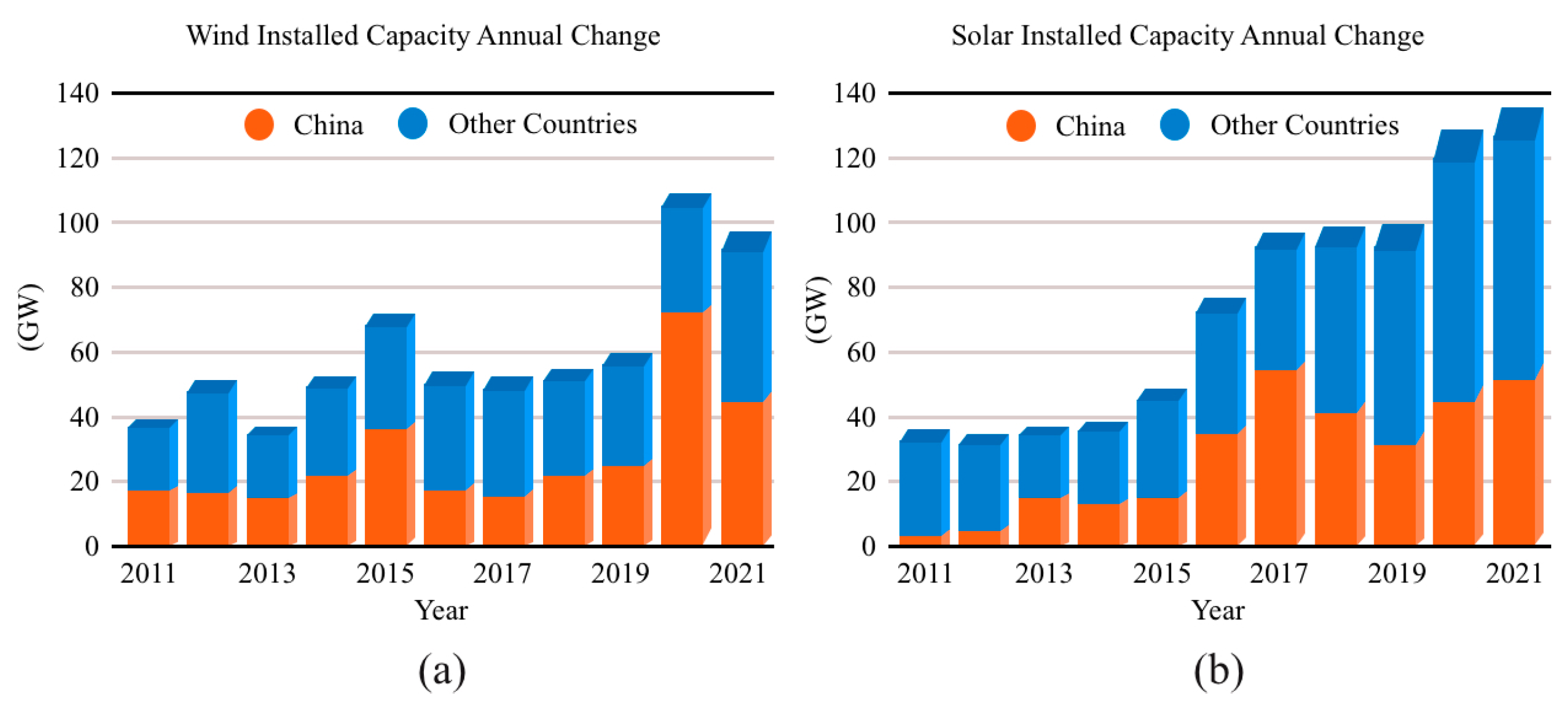
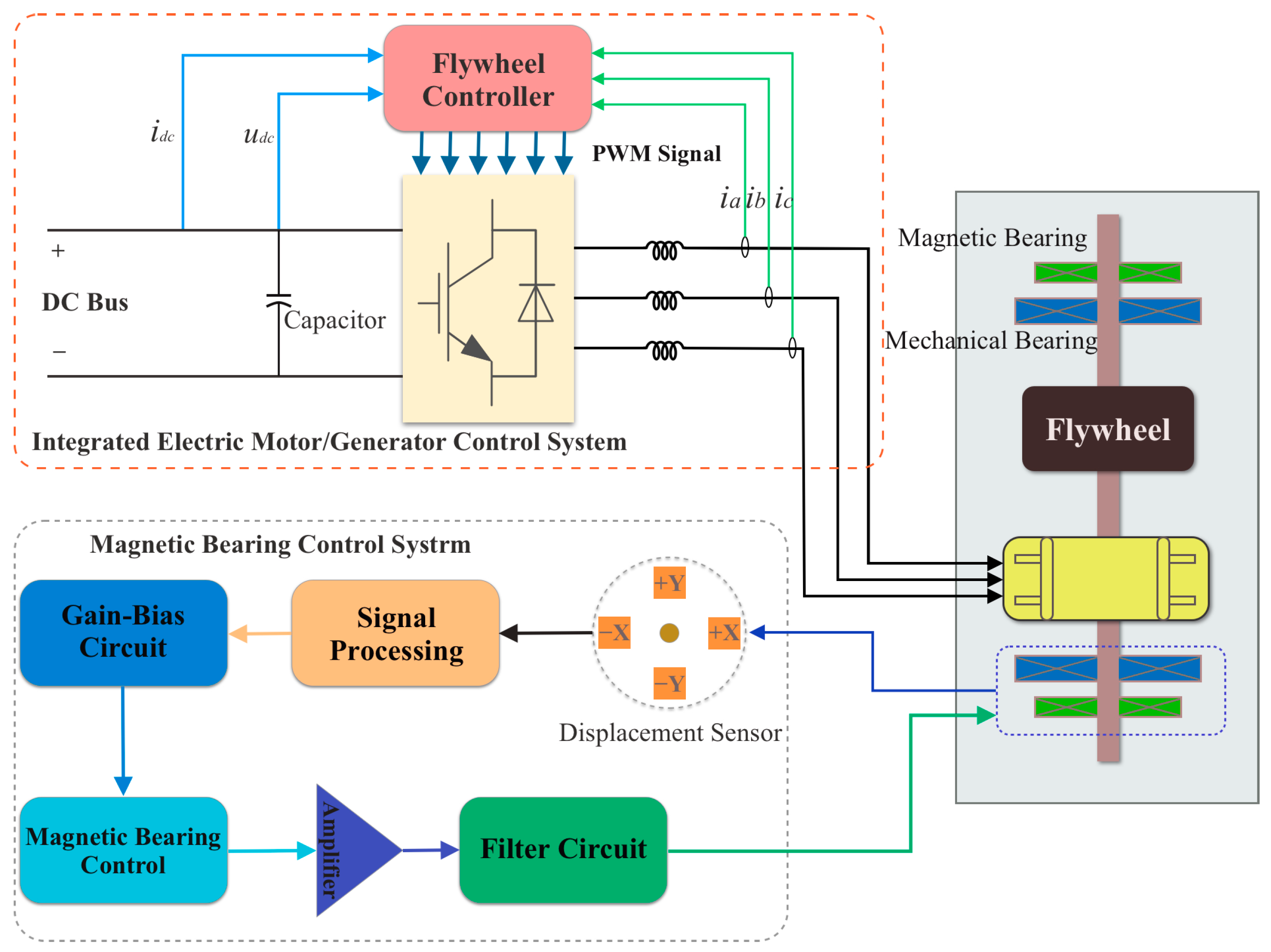


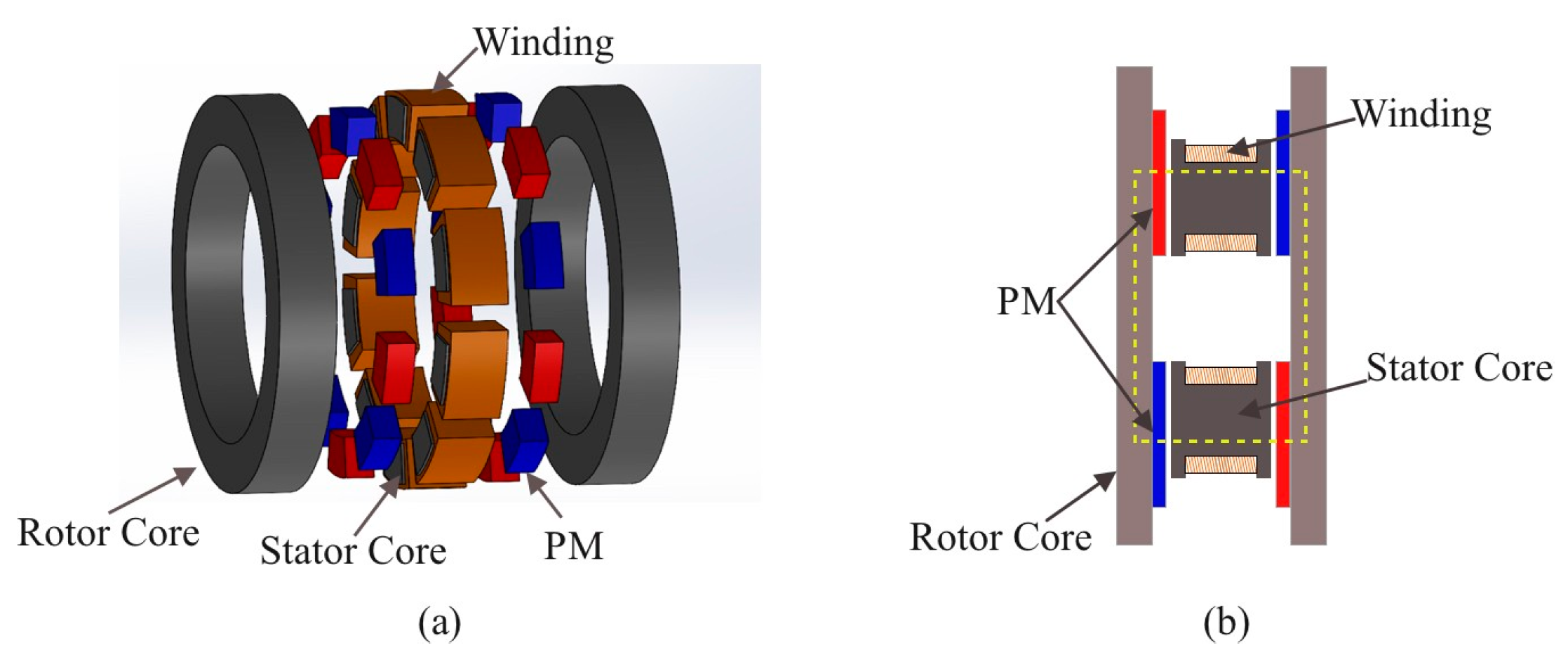




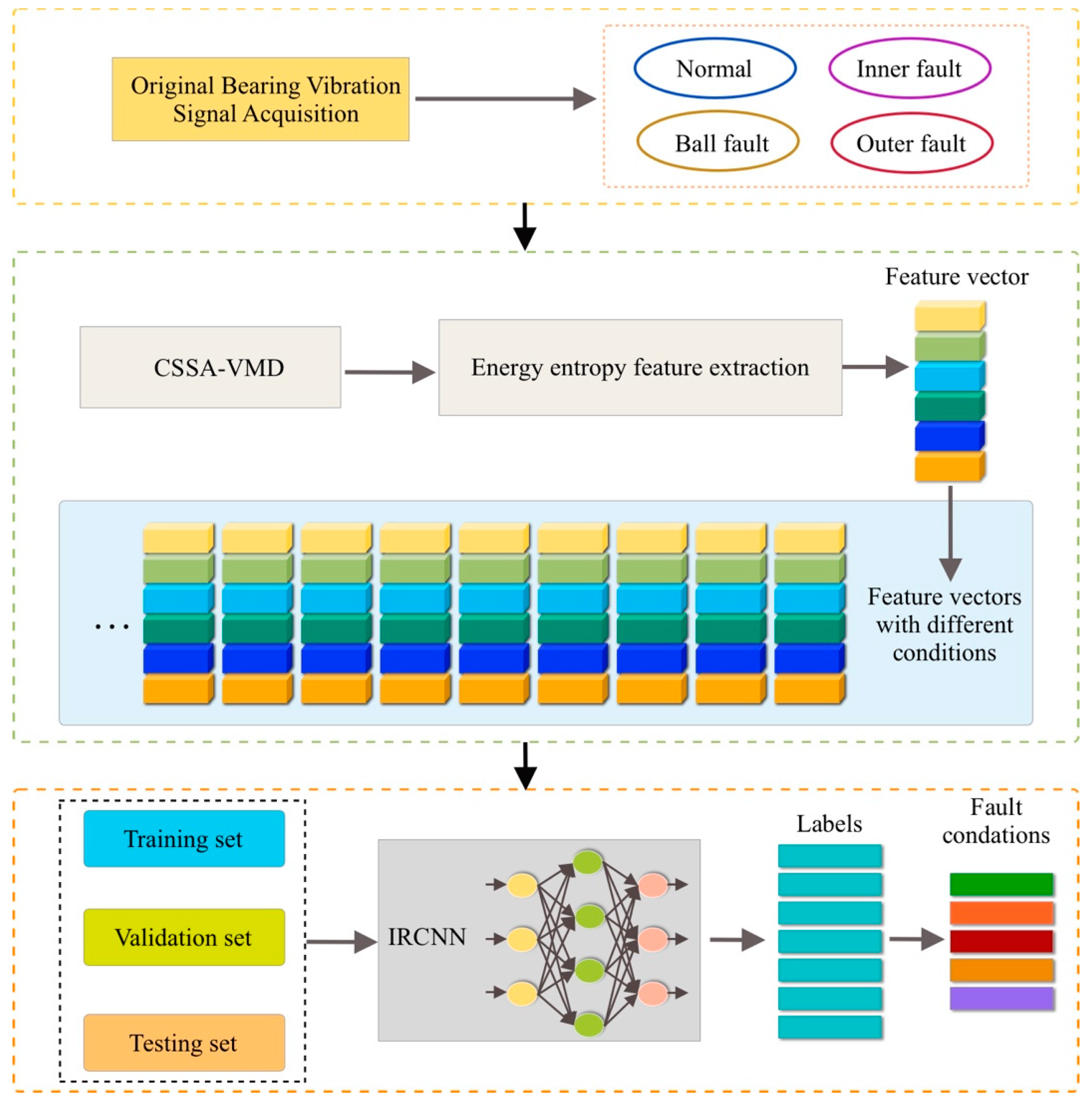
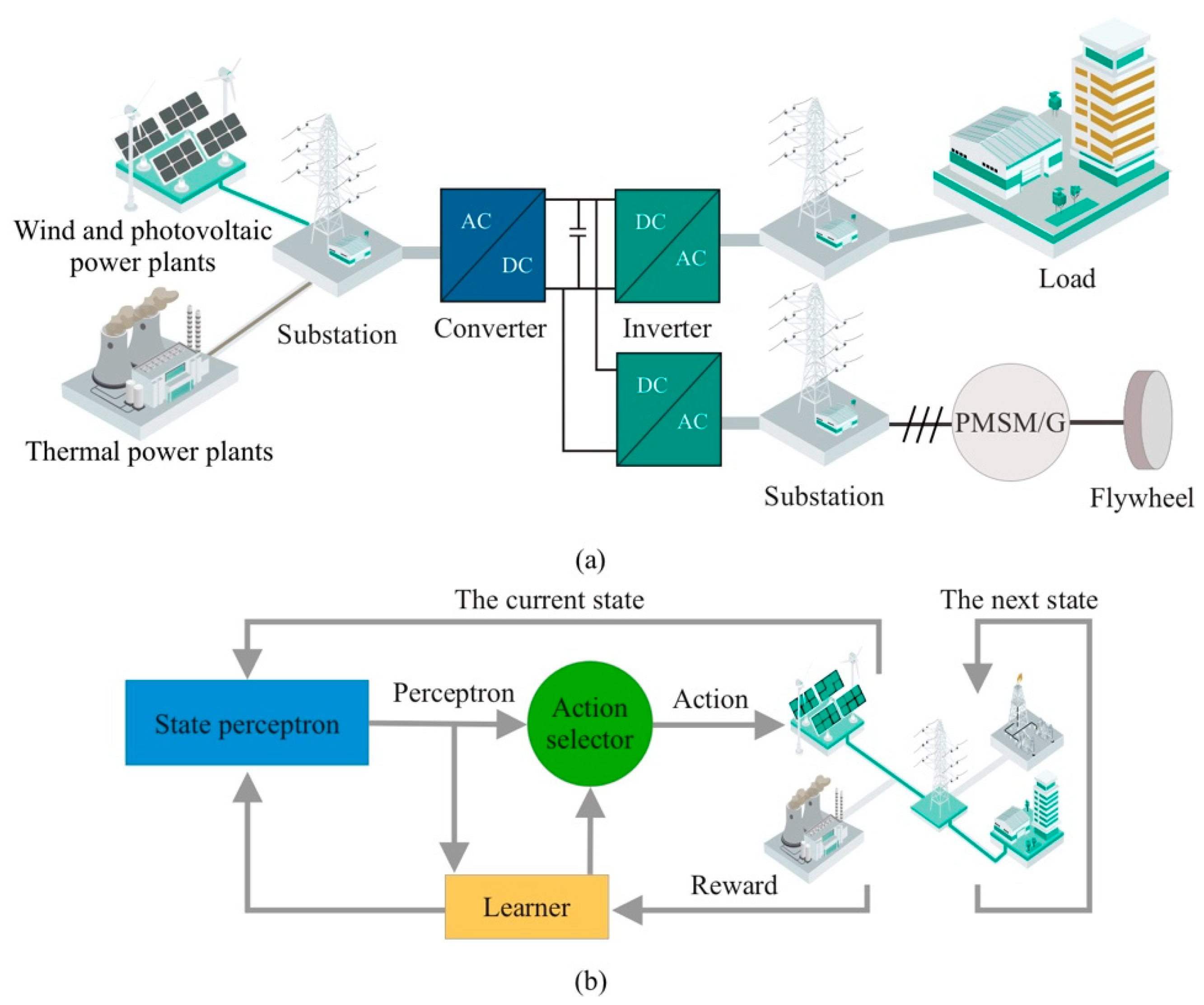
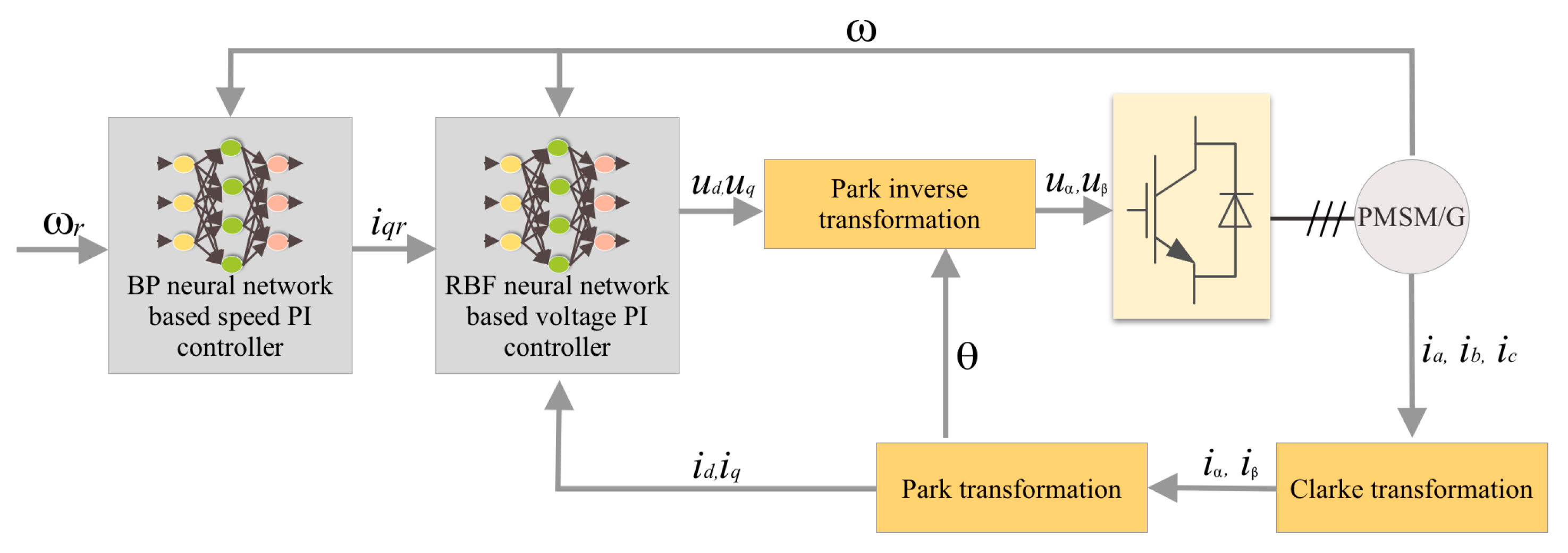
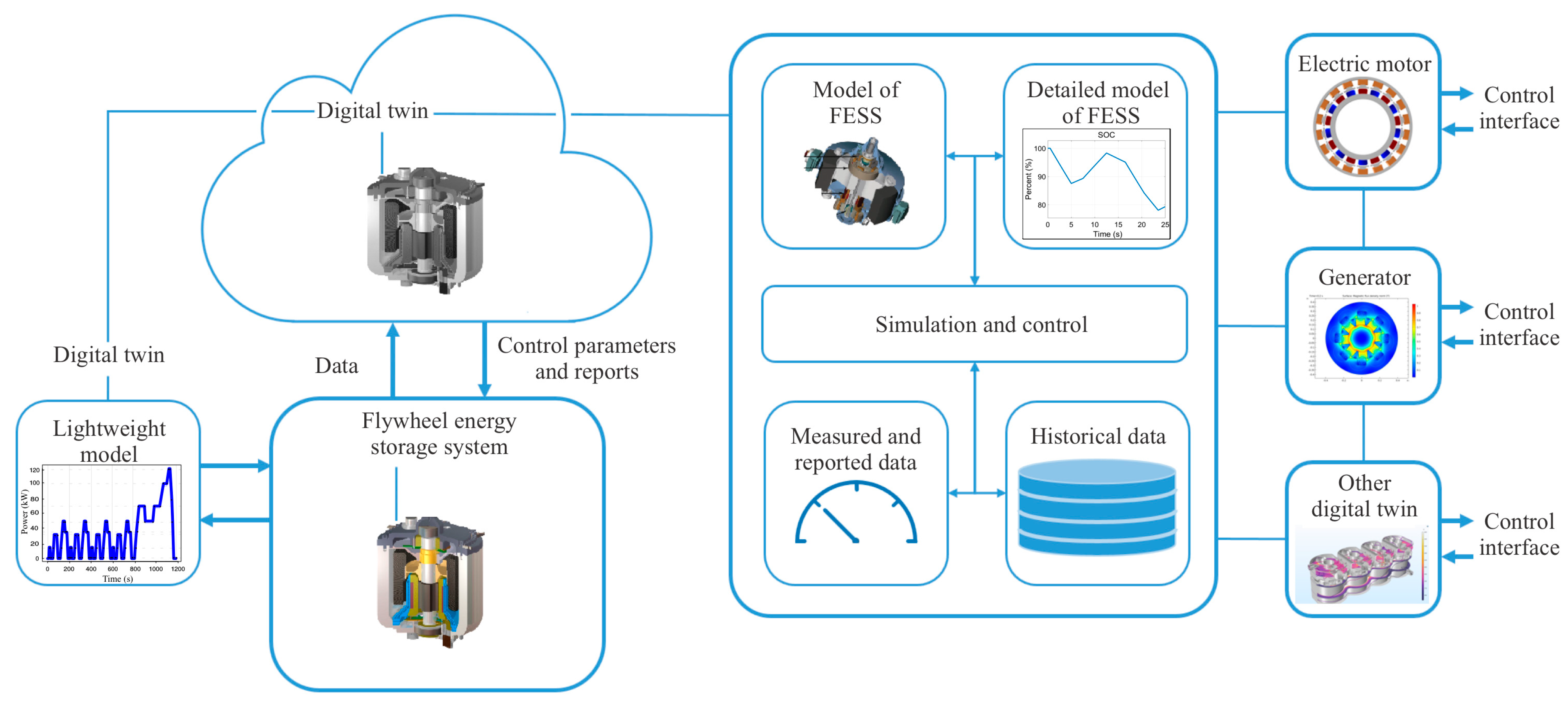

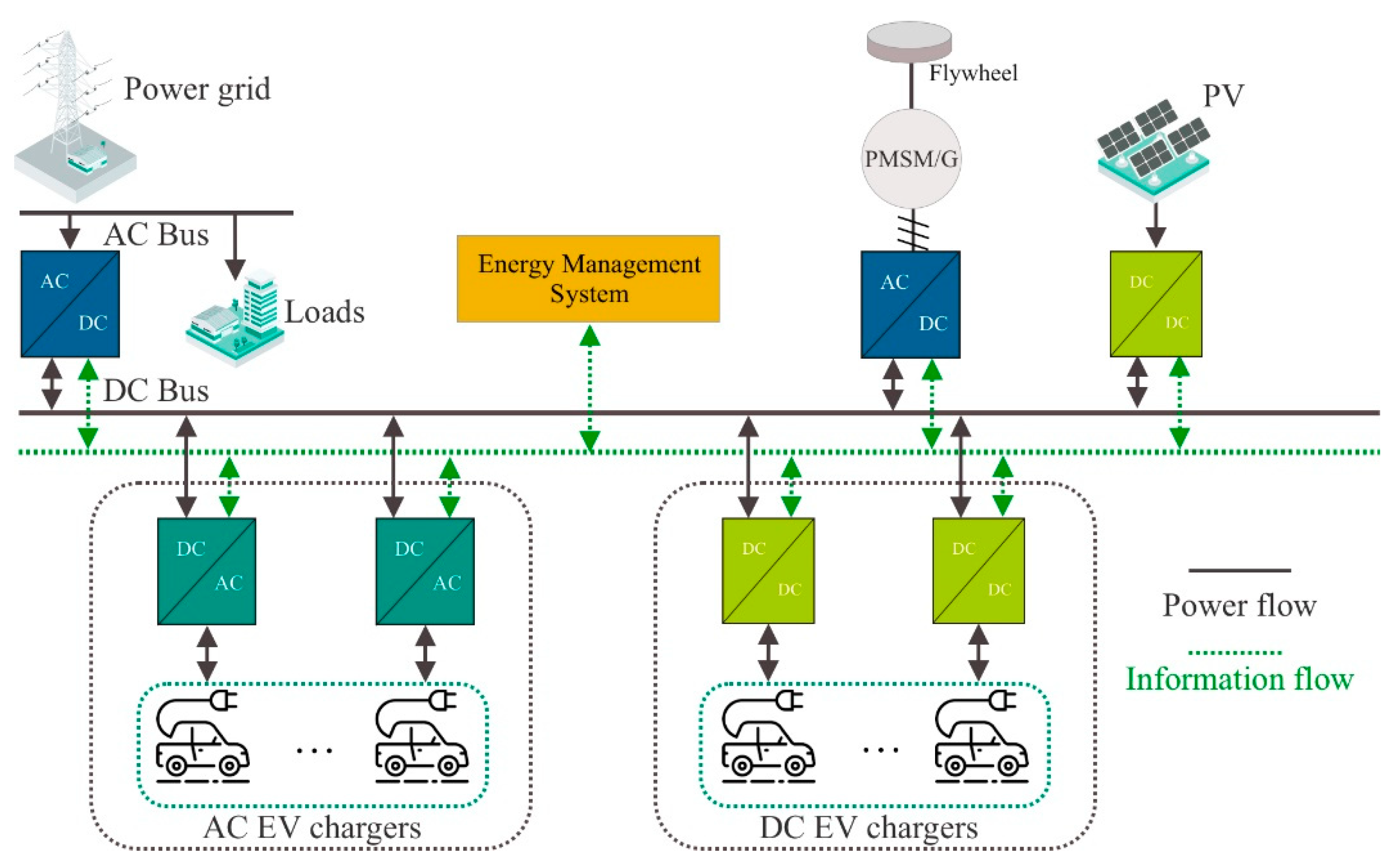

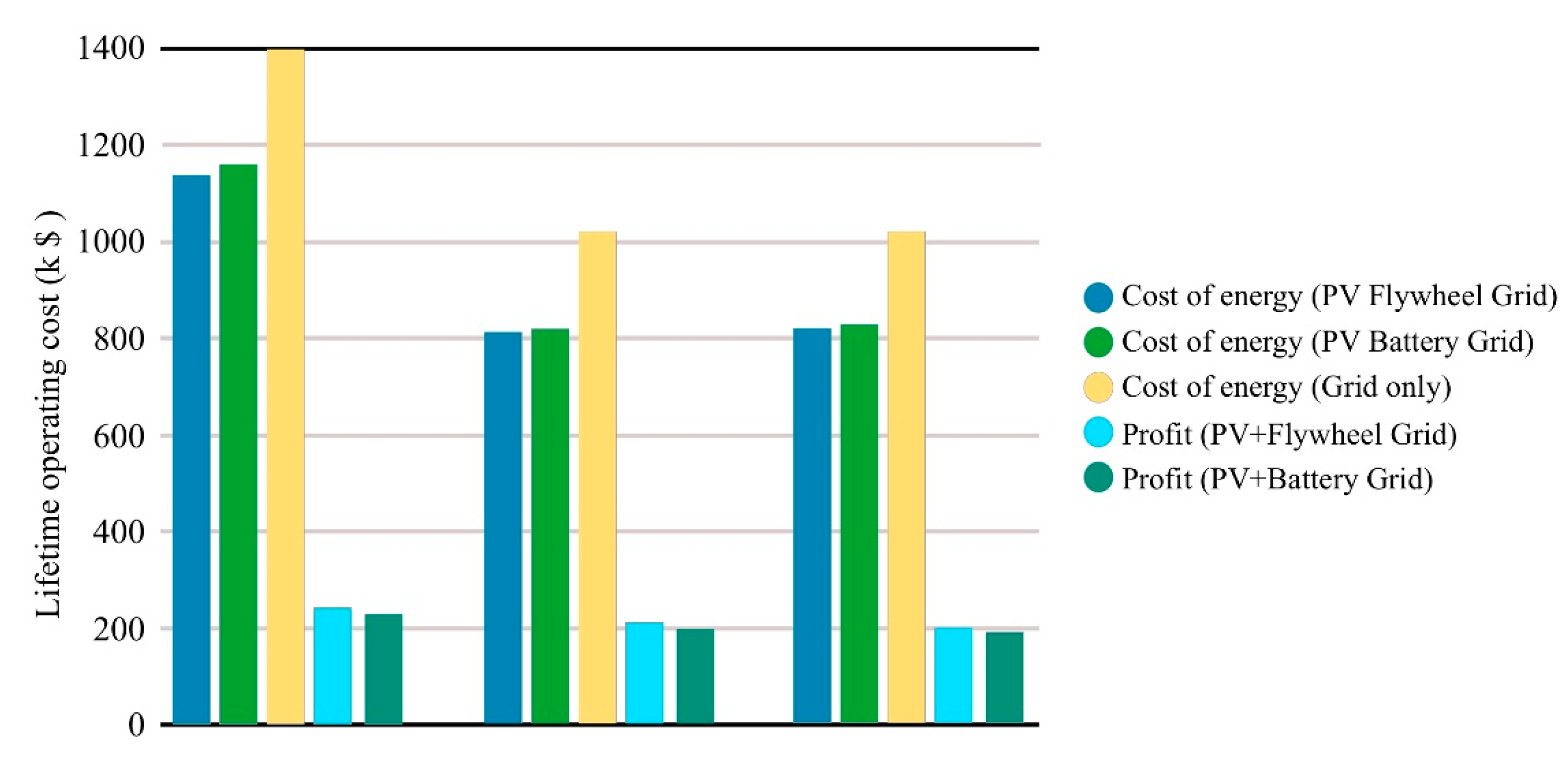
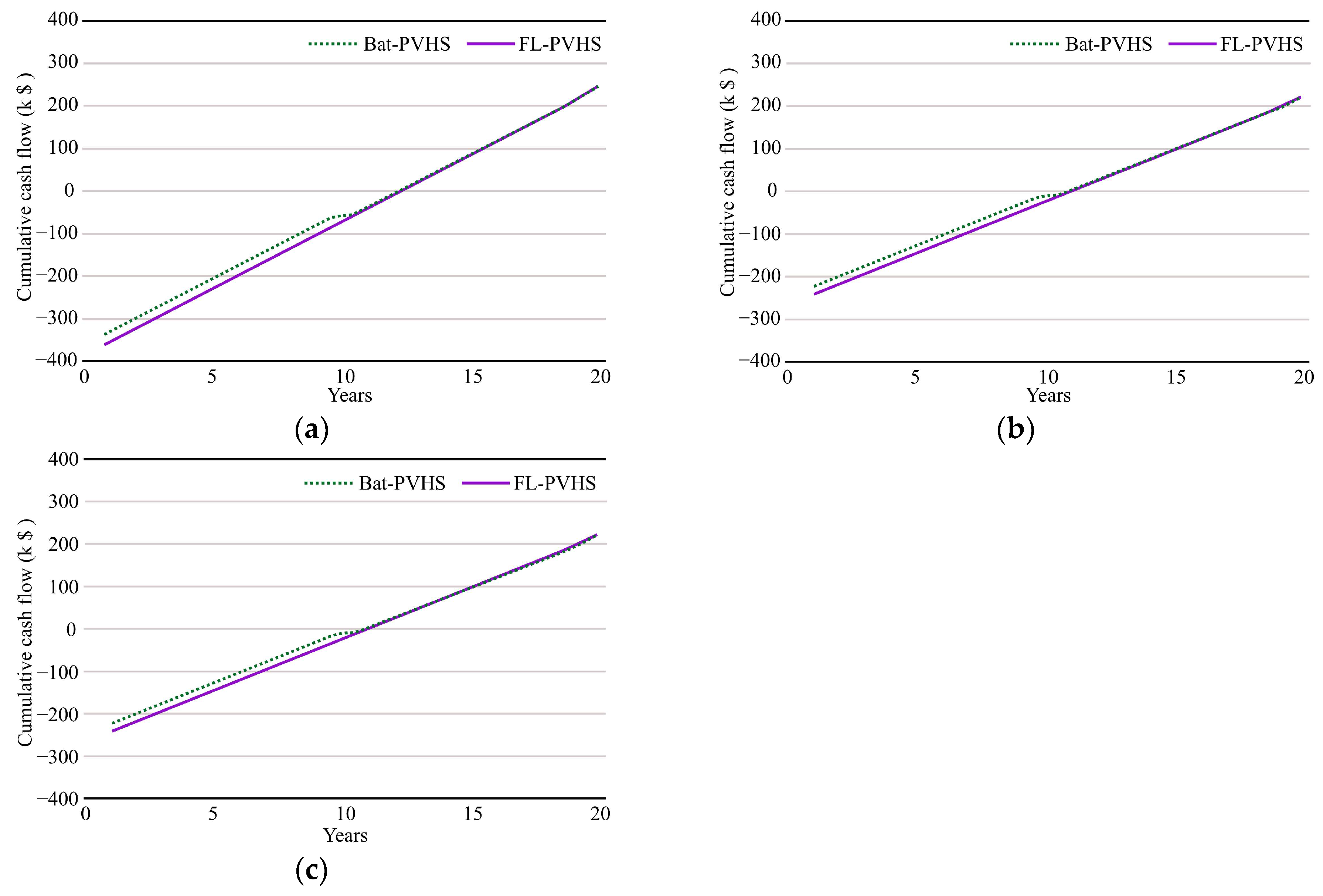
| Materials | Energy Storage of Different Materials | ||
|---|---|---|---|
| E glass fiber/resin | 3.5 | 2540 | 231.9 |
| S glass fiber/resin | 4.8 | 2530 | 320.6 |
| Kevlar | 3.8 | 1450 | 441.1 |
| Spectra fiber/resin | 3.0 | 970 | 520.6 |
| Carbon fiber T-1000/resin | 10 | 1800 | 945.7 |
| High-strength steel | 2.7 | 7800 | 56.8 |
| Aluminum alloy | 0.6 | 2700 | 36.1 |
| Features | Flywheel Motors | ||
|---|---|---|---|
| Induction Motor | Switched Reluctance Motor | Permanent Magnet Motor | |
| Output power | high | medium and low | medium and low |
| Specific power (kW/kg) | medium (~0.7) | medium (~0.7) | high (~1.2) |
| Rotor losses | copper and iron | iron loss | very low |
| Spinning losses | Removable by annulling flux | Removable by annulling flux | Non-removable, static flux |
| Efficiency (%) | High (91~94) | High (90) | Very High (95~97) |
| Control methods | Vector control | Synchronous: vector control. Switched: DSP | Sinusoidal: vector control. Trapezoidal: DSP |
| Size (l/kW) | 1.8 | 2.6 | 2.3 |
| Torque ripple | medium | high | medium |
| Maximum speed (rpm) | 900~15,000 | >15,000 | >30,000 |
| Demagnetization | no | no | yes |
| Cost | low | low | high |
| Bearing Type | Advantages and Disadvantages of Bearings | |
|---|---|---|
| Advantages | Disadvantages | |
| PMB | No power supply is required, a simple structure | Stable suspension cannot be achieved alone |
| AMB | Wear-free, low noise, no lubrication required, highly controllable | Amplifier losses are large, and the design and control are complex |
| SMB | Self-stabilizing | Requires a low-temperature chiller, large, and high-cost |
| Manufacturer | Rotor Material | Energy | Power | Duration | Application |
|---|---|---|---|---|---|
| Hitachi ABB [138] | - | - | 2 MW | - | Wind |
| Active Power [139] | Steel | 2.83 kW | 675 kW | 15 s | Various |
| Amber Kinetics [140] | Steel | 32 kW | 8 kW | 4 h | Various |
| Bacon Power [141] | Composite | 25 kWh | 100 kW | 15 min | Grid |
| Caterpillar [142] | - | 5 kWh | 675 kW | 15 s | UPS |
| Vycon [143] | Steel | 0.52 kWh | 125 kW | 15 s | UPS |
| Piller Group [144] | Steel | 2.9 kWh | 625 kW | 15 s | Various |
| Powerthru [145] | Composite | 0.53 kWh | 101 kW | 10–25 s | Defense |
| Rotonix [146] | Composite | 12 kWh | 1.1 MW | - | Various |
| Stornetic [147] | Composite | 3.6 kWh | 80 kW | 260 s | Grid |
| Applications | Advantages of Using FESSs |
|---|---|
| UPS | FESSs can quickly supply stored energy to fill short-term gaps when the main power source fails, making them ideal for critical systems like hospitals, data centers, and industrial processes. |
| Frequency Regulation | FESSs can quickly absorb or discharge energy to help maintain a stable frequency, thus aiding in grid stability. |
| Renewable Energy Integration | FESSs can store excess energy generated by renewable sources. Their ability to charge and discharge quickly makes them well-suited for dealing with the intermittent nature of these energy sources. |
| Public Transportation Systems | In electric trains or trams, FESSs can capture the energy generated during braking and then reuse it for acceleration or other energy needs, thus improving the overall efficiency of the system. |
| Peak Shaving | FESSs can store energy during periods of low demand and release it during peak hours. This can be particularly beneficial for industries with fluctuating power requirements, reducing their peak demand charges. |
| Load Leveling in Microgrids | For small-scale localized grids, FESSs can serve to balance loads and supply, particularly when these microgrids are powered by renewable energy sources with fluctuating outputs. |
| High-Cycling Operations | FESSs are less susceptible to wear and tear from frequent cycling (charging and discharging) compared with other forms of energy storage like batteries, making them suitable for applications requiring frequent energy charge/discharge cycles. |
| High-Power, Short-Duration Applications | In industrial processes that require a high amount of power in a short period, like laser cutting or electric arc furnaces, FESSs can efficiently deliver the required energy burst. |
| Achievements | Challenges | ||
|---|---|---|---|
| Features | Details | Features | Details |
| High Energy Density | Modern FESS units can store a considerable amount of energy, comparable to chemical batteries, making them suitable for various applications ranging from grid support to transportation. | High Initial Costs | The upfront costs, particularly for advanced systems with magnetic bearings and vacuum enclosures, can be a deterrent to widespread adoption. |
| Fast Charge/Discharge Rates | Their rapid charge and discharge capabilities make FESSs ideal for applications requiring instant high power, like UPS systems and frequency regulation. | Complex Engineering | Maintaining a rotating mass at very high speeds requires precision engineering and advanced materials, adding to the complexity and cost. |
| Long Lifespan | Flywheels can endure a large number of cycles without significant wear, extending their operational life and reducing long-term costs. | Safety Concerns | Flywheels storing a large amount of energy can be potentially hazardous in case of failure, leading to strict safety requirements for their installation and operation. |
| Environmental Friendliness | Flywheels do not contain harmful chemicals and are generally easier to recycle, making them an environmentally responsible choice for energy storage. | Size and Weight | The energy-to-weight ratio for FESSs is still generally less favorable than for some other storage options, making them less practical for mobile applications. |
| Efficiency | Advances in materials science for the flywheels have led to higher rotational speeds and thus increased efficiency in energy storage and retrieval. | Limited Energy Storage Time | Flywheels are not ideal for long-term energy storage, limiting their application in scenarios requiring extended periods of storage. |
| Operational Reliability | The mechanical nature of FESSs, as opposed to the chemical processes in batteries, leads to fewer failure modes, contributing to operational reliability. | Regulatory Hurdles | As a relatively new technology in the public sphere, there may be regulatory challenges that need to be addressed, including standards for safety, integration into existing grids, and environmental assessments. |
Disclaimer/Publisher’s Note: The statements, opinions and data contained in all publications are solely those of the individual author(s) and contributor(s) and not of MDPI and/or the editor(s). MDPI and/or the editor(s) disclaim responsibility for any injury to people or property resulting from any ideas, methods, instructions or products referred to in the content. |
© 2023 by the authors. Licensee MDPI, Basel, Switzerland. This article is an open access article distributed under the terms and conditions of the Creative Commons Attribution (CC BY) license (https://creativecommons.org/licenses/by/4.0/).
Share and Cite
Xu, K.; Guo, Y.; Lei, G.; Zhu, J. A Review of Flywheel Energy Storage System Technologies. Energies 2023, 16, 6462. https://doi.org/10.3390/en16186462
Xu K, Guo Y, Lei G, Zhu J. A Review of Flywheel Energy Storage System Technologies. Energies. 2023; 16(18):6462. https://doi.org/10.3390/en16186462
Chicago/Turabian StyleXu, Kai, Youguang Guo, Gang Lei, and Jianguo Zhu. 2023. "A Review of Flywheel Energy Storage System Technologies" Energies 16, no. 18: 6462. https://doi.org/10.3390/en16186462










